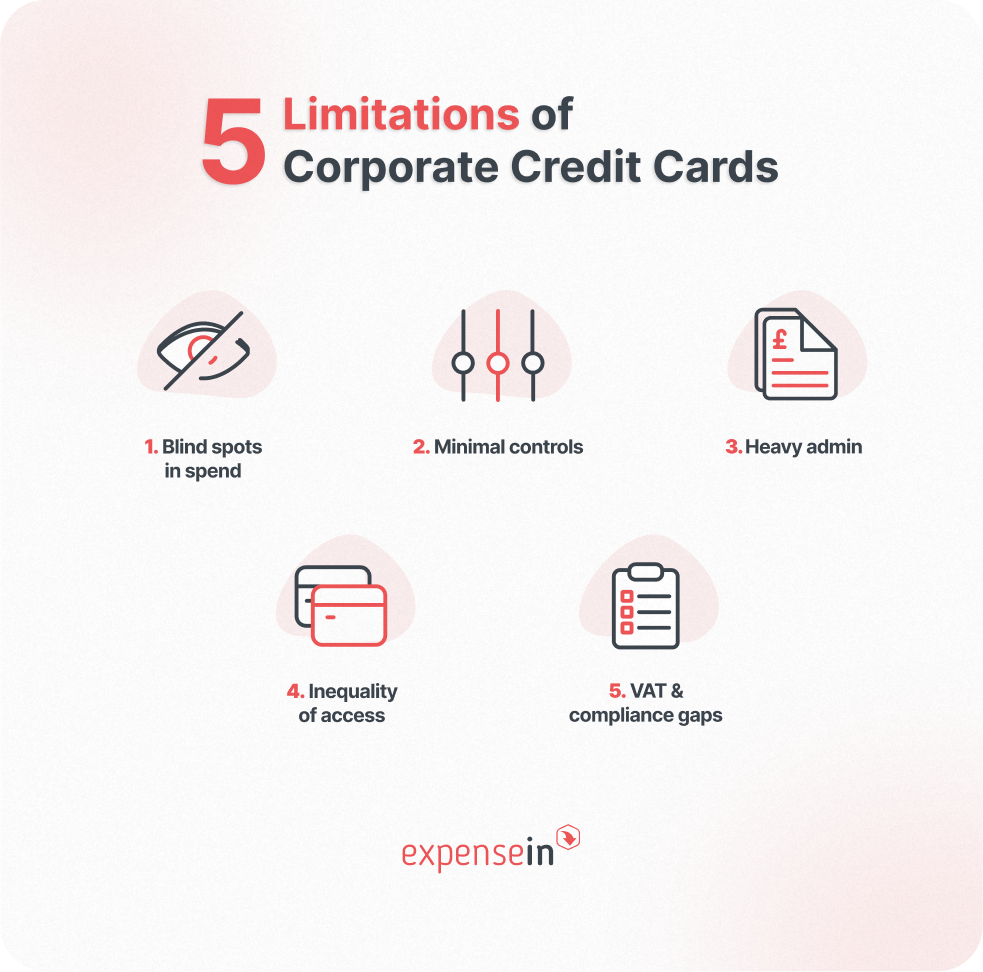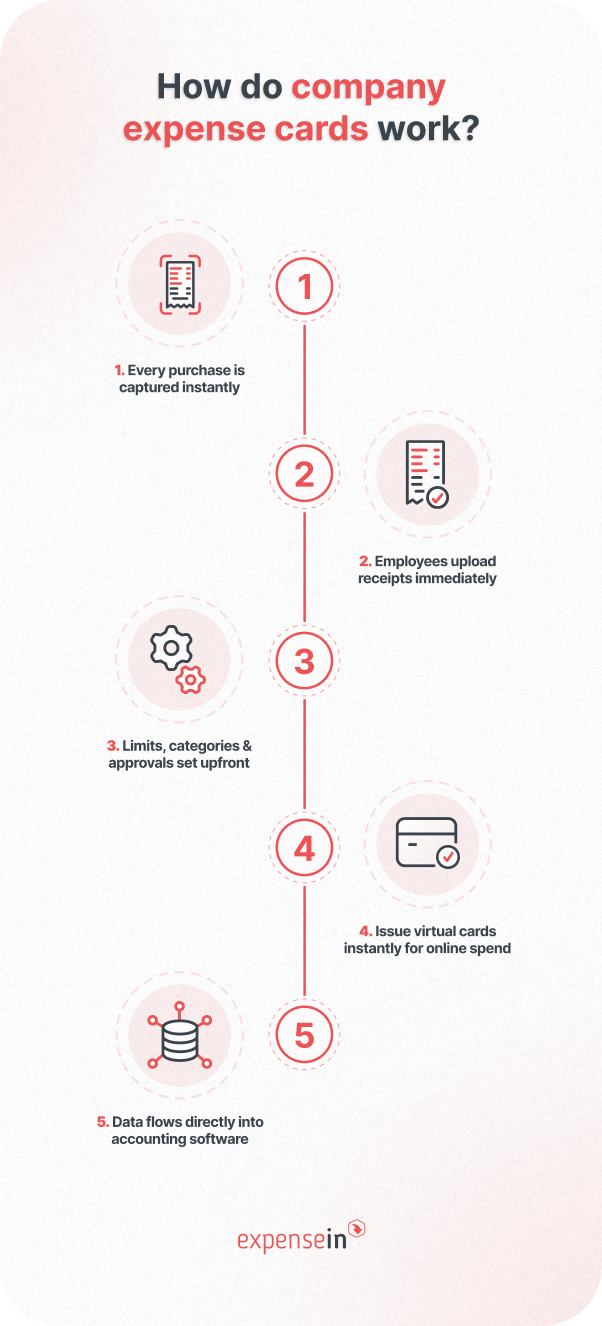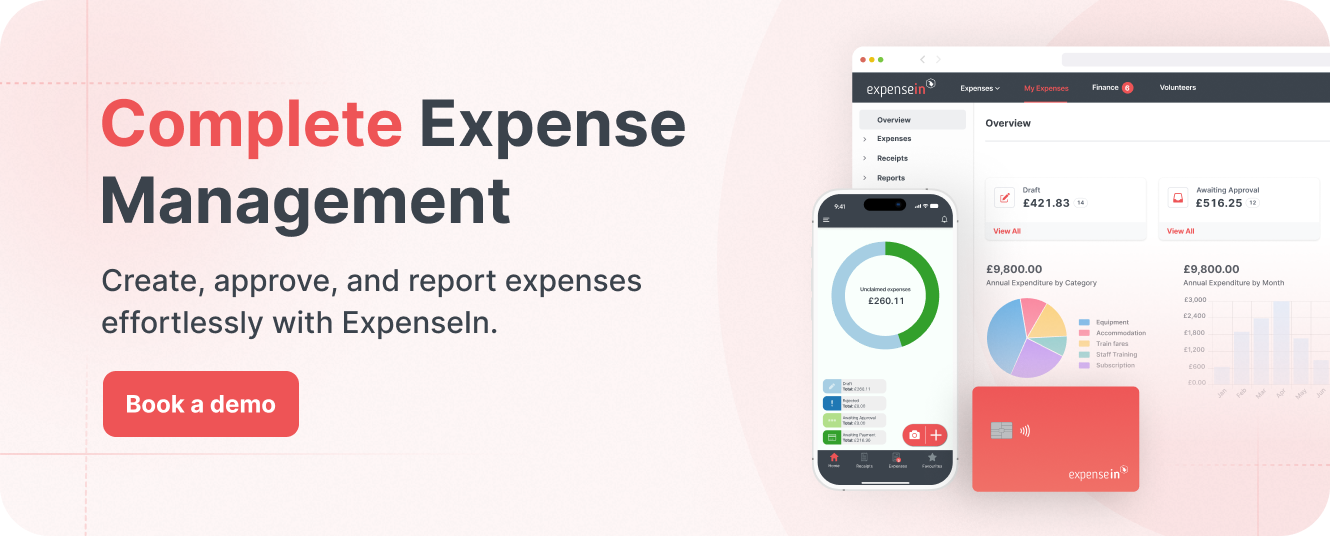Month-end. Again.
You’re buried in spreadsheets, chasing receipts that never seem to surface, and fielding Slack pings from employees who swear they already submitted that client dinner. For many UK finance teams, this cycle is all too familiar.
The numbers show just how broken the system is:
Employees leave over £140 million of expenses unclaimed each year because the process is too much of a hassle.
38% of staff don’t bother reclaiming certain expenses at all.
Among those who do, 81% say they’ve been left out-of-pocket for over a month, and almost half report that delays caused personal financial difficulties.
It’s clear: the way many businesses manage company spending isn’t working.
The question is, what’s the better tool: traditional corporate credit cards or modern expense cards?
Why Poor Spend Control Costs More Than You Think
For finance leaders, uncontrolled company spending directly affects the bottom line:
VAT leakage: Without valid receipts (or e-receipts), VAT can’t be reclaimed – a 20% uplift on many costs.
Compliance risk: HMRC requires full audit trails. Missing or incomplete records increase the risk of penalties and drawn-out audits.
Uncertain cash flow: Shadow spending and late visibility make accurate financial forecasting harder.
Productivity drain: Each manual expense report costs around £23 to process, and nearly 1 in 5 contain errors that require rework.
When spending isn’t controlled at the point of purchase, costs compound. Margins shrink, financial compliance weakens, and finance teams are stuck firefighting.
Read more about the hidden costs of unchecked corporate card spending.
Corporate Credit Cards: Useful, but Limited
Corporate credit cards were introduced to reduce expense reimbursement admin and stop employees from paying for business costs out of pocket.
They’re widely accepted, simple to use, and may even come with perks.
Advantages of corporate credit cards:
Employees aren’t left out of pocket
Cards are accepted almost everywhere
Cashback or points may add marginal value
A 30–55 day float can support short-term cash flow

Limitations of corporate credit cards:
Blind spots in spend: Finance often doesn’t see transactions until the statement arrives, too late to course correct.
Minimal controls: Credit limits exist, but they don’t prevent off-policy or duplicate purchases at the point of spend.
Heavy admin: Receipts still need to be collected, reconciled, and keyed into accounting systems.
Inequality of access: Only 19% of UK employees have a company expense card, leaving most still paying and reclaiming.
VAT and compliance gaps: Without receipts, VAT reclaim is lost, and HMRC audit risks increase.
A real-world example: Your sales director spends £3,000 on travel and meals. Finance doesn’t see the spend until the statement lands weeks later. By then, the travel budget is already blown, and two missing receipts mean £400 of VAT is lost.
Corporate cards reduce reimbursement pain, but often at the cost of visibility, compliance, and control.
The Rise of Company Expense Cards
Business expense cards were built to close the gap between payment and expense management.
They’re pre-funded company cards directly tied to an expense management software, giving finance real-time control and visibility.

How do company expense cards work?
Every purchase is captured and coded in real time.
Employees are prompted by their expense management app to upload receipts immediately.
Limits, categories, and approvals are set up front.
Virtual expense cards can be issued instantly for subscriptions or contractors.
Data flows directly into accounting software like AccountsIQ, Xero, Sage, or QuickBooks.
What this looks like in real life:
On the road: Instead of waiting for a statement, finance sees client dinner overspend as it happens and can intervene.
Subscriptions: Virtual cards prevent SaaS sprawl; each subscription has its own card with limits and can be cancelled with a click.
VAT reclaim: A receipt prompt at purchase reduces leakage and secures HMRC-ready records.
ERR compliance in Ireland: Transactions are automatically logged, categorised, and export-ready.
Company expense cards move spend control to the point of purchase, giving finance teams the tools to prevent issues instead of cleaning up after them.
Corporate Credit vs Expense Cards: Key Differences
Criteria | Corporate Credit Cards | Expense Cards |
|---|---|---|
Visibility | Low until statements | Real-time dashboard |
Controls | Credit limits only | Granular rules & approvals |
Receipts | Manual chase | Auto-captured at point of spend |
Compliance | Risk of gaps | HMRC-ready digital audit trail |
Admin burden | High (reconciliation & chasing) | Low (automated matching & exports) |
Employee access | Limited | Scalable to all staff |
Funding | Credit line (short-term float) | Pre-funded (no debt risk) |
Rewards | Cashback, points | Control & efficiency as the “reward” |
What these differences mean in practice
The differences between corporate credit cards and expense cards show up in four areas that matter most to finance teams:
Forecasting: Corporate cards only show spending when the statement arrives. That delay makes it harder to keep forecasts accurate. Expense cards provide live data so finance can adjust budgets in real time.
VAT and compliance: With corporate cards, a missing receipt means lost VAT recovery and weaker audit trails. Expense cards link every transaction to a digital receipt uploaded at the point of purchase, reducing leakage and keeping HMRC records complete.
Month-end close: Reconciling credit card statements remains a manual task. Expense cards feed coded transactions into accounting systems automatically, helping teams close faster and with fewer errors.
Accountability: Spend on corporate cards is often pooled, which blurs ownership. Expense cards tie transactions to individuals or teams as they happen, creating a clearer line of responsibility.
For finance leaders, these benefits change how smoothly budgets are managed, how confidently audits are handled, and how much time the team spends on admin versus analysis.
How Finance Leaders Should Decide
The choice often comes down to what matters most for you.
Here are some questions worth asking:
Question | Corporate Credit Card | Expense Card |
|---|---|---|
Is real-time visibility of spend a must? | ❌ No – statement lag | ✅ Yes – live dashboard |
Do you need receipts captured at purchase? | ❌ No – receipts often missed | ✅ Yes – instant prompts & attach |
Should policy controls/approvals be enforced before spend? | ❌ No – limits only | ✅ Yes – rules, categories, approvals |
Do you want to stop out-of-pocket employee spend? | ❌ No – limited card access | ✅ Yes – cards for all who need them |
Is maximising VAT recovery and an HMRC-ready audit trail essential? | ❌ No – gaps without receipts | ✅ Yes – digital receipts per transaction |
Do you need a faster month-end with auto-coding & direct exports? | ❌ No – manual reconciliation | ✅ Yes – sync to accounting system |
Do you require ERR-ready categorisation and exports (Ireland)? | ❌ No – incomplete data | ✅ Yes – real-time categories & exports |
Do you want tight control of subscriptions via virtual cards? | ❌ No – hard to isolate/cancel | ✅ Yes – one card per subscription, easy caps |
Do you prefer pre-funded spend with no interest or debt risk? | ❌ No – relies on credit | ✅ Yes – pre-funded model |
Do you need to scale card access quickly across teams? | ❌ No – slow bank processes | ✅ Yes – instant issue (physical & virtual) |
For most finance leaders, the real hidden costs aren’t in missed cashback points but in leaked spend, wasted hours, and lost VAT reclaim.
That’s why more and more UK businesses are moving to expense cards.
They offer the convenience of a card without the chaos of reconciliation, delivering a finance process that’s both efficient and employee-friendly.
Why ExpenseIn’s Expense Cards Work for UK & Irish Businesses
Not all expense cards are equal.
ExpenseIn’s expense card was designed for UK and Irish businesses dealing with VAT, ERR, and the pressure of tight finance teams.

End-to-end solution: Cards, expenses, approvals, and real-time reporting all sit in one expense management system.
Real-time prompts: Staff are reminded to capture receipts immediately; finance gets alerts for out-of-policy spend.
Granular controls: Set limits per card, block categories, or freeze instantly.
One central balance: Top up once, allocate across physical and virtual business cards.
Compliance built in: HMRC-ready digital receipts and VAT tracking as standard.
Flexible issue: Physical cards for travellers, virtual cards for online spend, like subscriptions or department budgets.
Seamless integrations: Sync transactions directly with leading accounting platforms such as AccountsIQ, Xero, Sage, and QuickBooks.
The result: no more out-of-pocket costs, no more receipt-chasing, and no surprises at month-end.
 Company Expense Cards: Smarter Spend, Happier Teams
Company Expense Cards: Smarter Spend, Happier Teams
Corporate credit cards solved reimbursements, but they didn’t fix the bigger issues of visibility, compliance, and control.
Company expense cards do. They empower employees to spend company money responsibly, while giving finance teams the tools to stay ahead of spend, not chase it after the fact.
For finance leaders in the UK and Ireland, expense cards are emerging as the smarter, more scalable choice.
And with ExpenseIn, you can make the switch without disruption. Book a demo today and see how much easier month-end can be.



